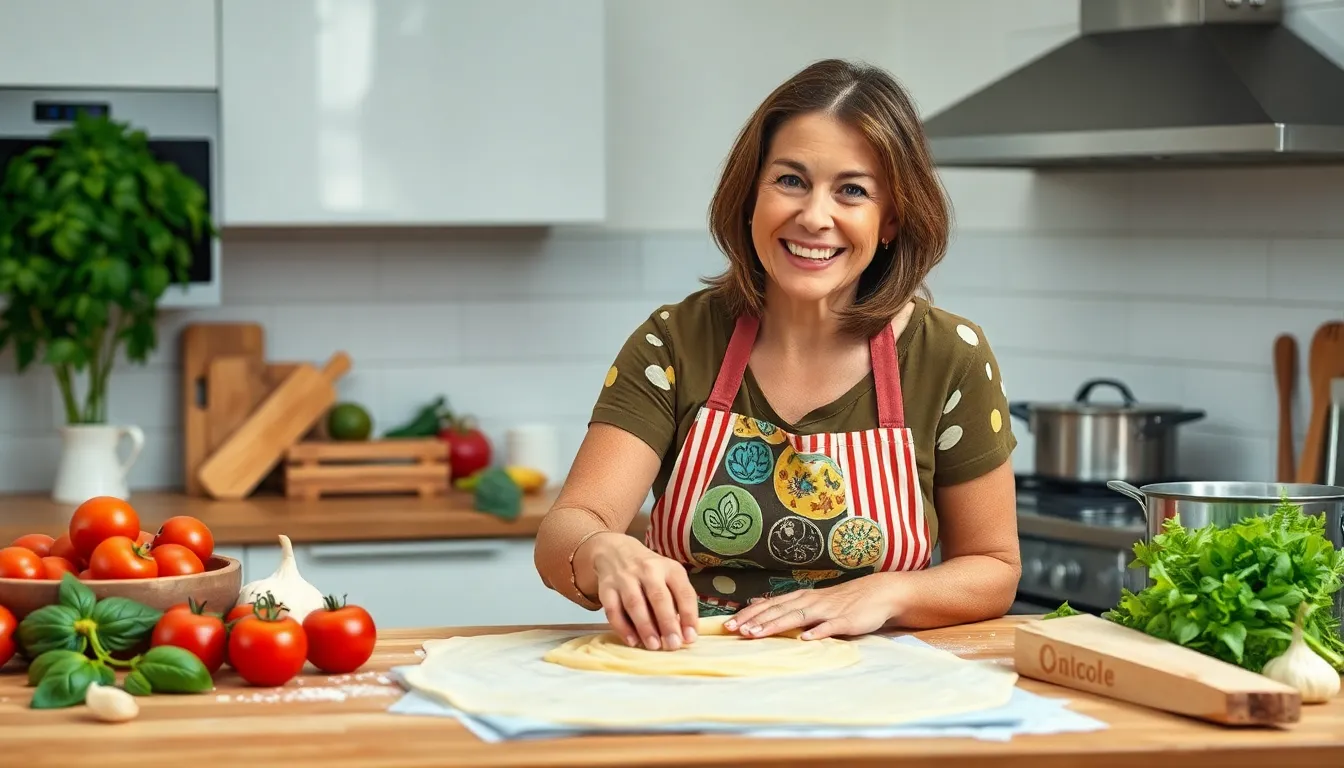Italian cooking isn’t just about tossing pasta in boiling water and calling it a day. It’s an art form, a love language spoken through simmering sauces and perfectly seared meats. From the bustling streets of Rome to the sun-drenched hills of Tuscany, each technique tells a story, inviting home cooks to step into the kitchen and unleash their inner Italian chef.
Table of Contents
ToggleOverview of Italian Cooking Techniques
Italian cooking techniques embody centuries of tradition and regional diversity. Techniques vary significantly between regions, reflecting local ingredients and customs. For example, northern Italy often utilizes creamy sauces and risottos while southern Italy favors olive oil and tomatoes.
Roasting holds an important place in Italian cuisine. Chefs often roast meats such as lamb and pork, enhancing flavors with herbs like rosemary and garlic. This method results in tender, flavorful dishes that showcase the essence of Italian cooking.
Grilling also plays a vital role. Grilled vegetables and meats, often seasoned simply with salt and olive oil, create dishes that celebrate fresh ingredients. The technique brings a charred flavor that elevates the overall dining experience.
Sautéing frequently complements pasta dishes. This technique involves cooking ingredients quickly in olive oil over high heat, preserving flavors and nutrients. Combining garlic, vegetables, and proteins before adding pasta enhances the dish’s complexity.
Braising serves as another cornerstone. This low and slow method involves cooking tougher cuts of meat in liquid until tender. Recipes like osso buco demonstrate how braising can transform ingredients into mouthwatering masterpieces.
Emphasizing simplicity, Italian cooking encourages using high-quality, seasonal ingredients. Fresh produce and artisanal products, like cheese and bread, remain integral to meal preparation. Understanding these techniques allows cooks to capture the spirit of Italian cuisine in their kitchens.
Mastering these techniques opens a world of culinary exploration. Each method contributes to the creation of dishes that are not only nourishing but also rich in flavor and history. Italian cooking invites enthusiasts to embrace regional traditions while developing their unique style.
Basic Techniques

Italian cooking incorporates several fundamental techniques that enhance flavor and preserve the integrity of ingredients. Mastery of these techniques lays the foundation for creating authentic dishes.
Chopping and Slicing
Chopping and slicing form the basis of Italian food preparation. Precision in cutting vegetables ensures uniform cooking, which promotes even flavors. Chefs often use a chef’s knife for efficiency, allowing for quick and consistent results. Garlic, a staple in many Italian recipes, benefits from finely minced preparation that releases essential oils. Slicing tomatoes or bell peppers thinly enhances texture in salads and sauces, ensuring each bite is flavorful. Hearty ingredients like onions should be diced carefully, as they contribute depth to sauces and stews.
Roasting and Baking
Roasting and baking elevate ingredients through dry heat, concentrating flavors. Roasting vegetables caramelizes sugars, making them sweet and tender, enhancing their natural taste. Olive oil, herbs, and spices often accompany vegetables to maximize flavor. Baking, particularly in the preparation of bread or pasta, creates enticing textures and aromas. Pizza originates from traditional baking methods, where a hot oven produces a crispy crust. Achieving the perfect roast or baked dish relies on using quality ingredients and monitoring cooking times for optimal outcomes.
Flavoring Techniques
Flavoring techniques play a vital role in Italian cooking, enriching dishes with depth and character.
Herbs and Spices
Fresh herbs and spices enhance Italian dishes significantly. Basil, oregano, and parsley deliver bright flavors, while rosemary and thyme add earthy notes. Garlic and red pepper flakes provide boldness to sauces and sautés. Italians often incorporate herbs early to infuse oils and build flavors gradually. Spices like black pepper and nutmeg elevate both savory and sweet recipes. Each herb and spice complements different ingredients, highlighting the regional characteristics of Italian cuisine. Quality matters greatly, so using fresh, local herbs maximizes taste in dishes.
Sauces and Marinades
Sauces are vital to Italian flavor profiles. Classic sauces include marinara, alfredo, and pesto, each bringing unique tastes to pasta and meats. Tomato-based sauces derive richness from simmered tomatoes, garlic, and olive oil. Emphasis on balance is crucial, as both acidity and sweetness must harmonize in tomato sauces. Marinades infuse meats and vegetables with layers of flavor. Common ingredients like olive oil, vinegar, and fresh herbs soften proteins while imparting robust tastes. The layering of flavors in sauces and marinades is essential for authenticity and satisfaction in every bite.
Cooking Methods
Italian cooking methods showcase diverse techniques essential for creating flavorful dishes. These methods reflect regional traditions and emphasize the importance of quality ingredients.
Boiling and Simmering
Boiling serves as a foundational method in Italian cooking. Ingredients like pasta and vegetables benefit from this technique, which cooks them quickly in water or broth. Simmering, on the other hand, emphasizes gentle heat, ideal for developing flavors in sauces and soups. It typically involves maintaining a temperature just below boiling. Utilizing simmering allows flavors from herbs, spices, and ingredients to meld together, enhancing the final dishes. Precision plays a crucial role. Monitoring cooking times ensures that ingredients maintain their texture and nutritional value.
Grilling and Broiling
Grilling in Italian cuisine highlights fresh, seasonal ingredients. This method typically occurs outdoors and uses direct heat from below, creating a distinct char and smoky flavor. Vegetables like zucchini and bell peppers, along with meats like chicken and pork, shine when grilled. Broiling, similar to grilling, involves cooking food under high heat, usually in an oven. The use of broiling allows for quick cooking, achieving a crisp exterior while keeping the interior moist. Both methods, grilling and broiling, foster a connection to Italian traditions of using simple techniques to elevate the natural flavors of ingredients.
Advanced Techniques
Advanced techniques elevate Italian cooking, showcasing precision and creativity in the kitchen. Mastering these methods opens up a world of culinary possibilities.
Sous Vide
Sous vide involves vacuum-sealing food in a bag and cooking it in a water bath at a controlled temperature. This technique ensures even cooking and retention of moisture, resulting in tender meats and vibrant vegetables. Vegetables benefit from enhanced flavors as cooking at lower temperatures preserves their natural textures and nutrients. Meats achieve extraordinary tenderness, as sous vide allows them to cook slowly without the risk of overcooking. Recipes featuring sous vide often include meats like chicken, beef, or pork, showcasing the versatility of this method. With precise temperature control, chefs can replicate results consistently, making this technique popular among culinary professionals and enthusiasts alike.
Fermenting and Preserving
Fermenting and preserving techniques add depth to Italian dishes while extending ingredient shelf life. Techniques such as pickling or fermenting vegetables create tangy flavors that enhance sauces, salads, and antipasti. Commonly used ingredients include cucumbers, peppers, and cabbage, each offering unique tastes and textures. Additionally, fermentation processes help develop rich flavors in products like cheese and cured meats, essential components of Italian cuisine. These processes benefit from time and attention but yield results that elevate the dining experience. Preserved lemons, for instance, introduce a remarkable sourness to sauces and dressings, enhancing overall flavor complexity. Embracing these techniques fosters a connection to traditional Italian cooking, celebrating regional diversity and artistry in the kitchen.
Italian cooking techniques offer a rich tapestry of flavors and traditions that reflect the heart of Italy. By mastering these methods home cooks can transform everyday meals into extraordinary culinary experiences. The emphasis on quality ingredients and regional diversity invites everyone to explore their creativity in the kitchen.
Whether it’s the precision of chopping or the art of roasting, each technique plays a vital role in creating authentic dishes. Embracing these practices not only enhances flavor but also fosters a deeper appreciation for the cultural heritage behind Italian cuisine. With passion and practice anyone can bring the essence of Italy to their dining table.






